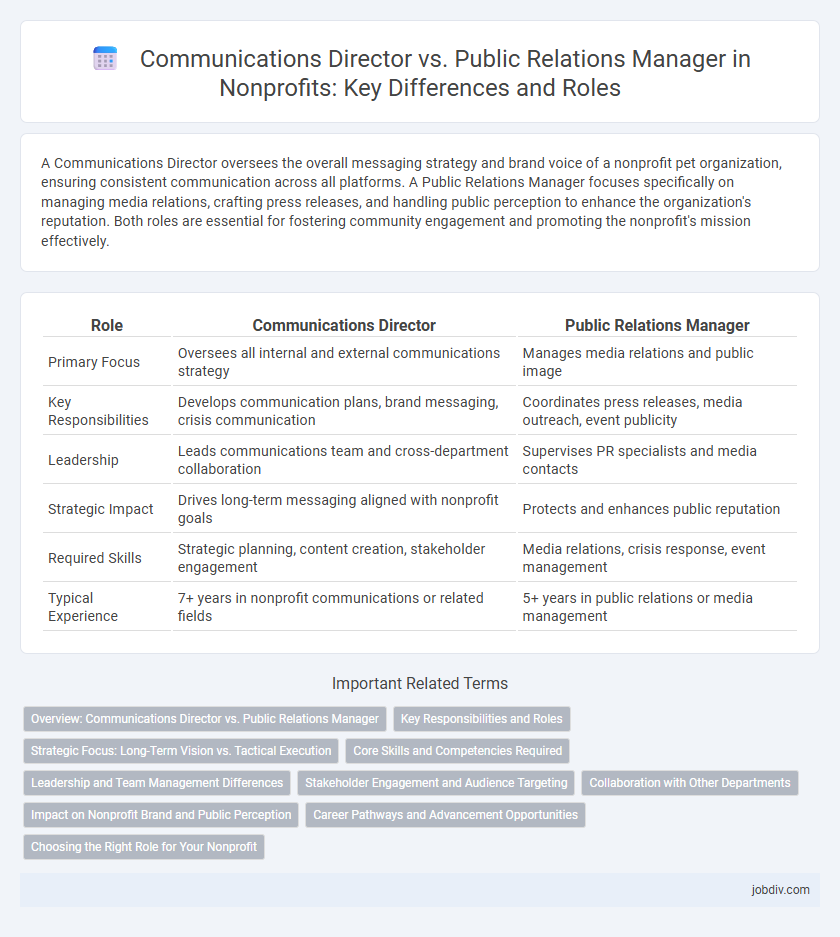A Communications Director oversees the overall messaging strategy and brand voice of a nonprofit pet organization, ensuring consistent communication across all platforms. A Public Relations Manager focuses specifically on managing media relations, crafting press releases, and handling public perception to enhance the organization's reputation. Both roles are essential for fostering community engagement and promoting the nonprofit's mission effectively.
Table of Comparison
| Role | Communications Director | Public Relations Manager |
|---|---|---|
| Primary Focus | Oversees all internal and external communications strategy | Manages media relations and public image |
| Key Responsibilities | Develops communication plans, brand messaging, crisis communication | Coordinates press releases, media outreach, event publicity |
| Leadership | Leads communications team and cross-department collaboration | Supervises PR specialists and media contacts |
| Strategic Impact | Drives long-term messaging aligned with nonprofit goals | Protects and enhances public reputation |
| Required Skills | Strategic planning, content creation, stakeholder engagement | Media relations, crisis response, event management |
| Typical Experience | 7+ years in nonprofit communications or related fields | 5+ years in public relations or media management |
Overview: Communications Director vs. Public Relations Manager
A Communications Director in a nonprofit typically oversees the organization's overall communication strategy, including internal communications, media relations, and brand messaging. In contrast, a Public Relations Manager primarily focuses on managing the nonprofit's public image, media outreach, and crisis communication. Both roles require strategic communication skills but differ in scope, with the Communications Director holding a broader, leadership-oriented position.
Key Responsibilities and Roles
The Communications Director in a nonprofit oversees the overall messaging strategy, ensuring alignment with organizational goals and managing internal and external communications teams. The Public Relations Manager focuses on building and maintaining the nonprofit's public image, handling media relations, press releases, and crisis communication. Both roles collaborate closely to enhance visibility, attract donors, and engage stakeholders effectively.
Strategic Focus: Long-Term Vision vs. Tactical Execution
A Communications Director in a nonprofit organization prioritizes strategic focus by developing long-term vision and comprehensive communication plans that align with the organization's mission and growth objectives. In contrast, a Public Relations Manager emphasizes tactical execution by managing day-to-day media relations, crafting press releases, and organizing events to enhance public image and stakeholder engagement. Together, their roles ensure both visionary leadership and effective implementation of communication strategies.
Core Skills and Competencies Required
Communications Directors in nonprofits require expertise in strategic messaging, brand management, and leadership skills to oversee integrated communication campaigns. Public Relations Managers focus on media relations, crisis communication, and storytelling abilities to maintain a positive public image. Both roles demand proficiency in digital media, content creation, and relationship-building with stakeholders but differ in scope, with Directors leading broader communication strategy and Managers executing targeted PR initiatives.
Leadership and Team Management Differences
The Communications Director in a nonprofit typically holds a higher leadership role, overseeing strategic communication goals and aligning messaging with the organization's mission, while managing diverse teams across multiple communication channels. In contrast, the Public Relations Manager focuses more on executing specific PR campaigns and maintaining media relations, often leading a smaller team or collaborating closely with external vendors. The Communications Director's role demands broader team management skills and long-term planning, whereas the PR Manager concentrates on tactical leadership and day-to-day public engagement.
Stakeholder Engagement and Audience Targeting
Communications Directors in nonprofits oversee comprehensive stakeholder engagement strategies, ensuring consistent messaging across diverse audience segments, whereas Public Relations Managers focus more specifically on cultivating media relations and targeted outreach campaigns. The Communications Director employs data-driven insights to tailor communication plans that align with organizational goals and foster long-term donor and volunteer loyalty. Public Relations Managers prioritize audience targeting through press releases, events, and social media to enhance public perception and drive immediate engagement outcomes.
Collaboration with Other Departments
Communications Directors and Public Relations Managers in nonprofit organizations collaborate closely with fundraising, program, and leadership teams to ensure consistent messaging and unified strategic goals. The Communications Director oversees broad communication strategies and coordinates between departments to align messaging across all channels. Public Relations Managers focus on managing the organization's public image and media relations, working with various teams to tailor messages that support fundraising campaigns, events, and advocacy initiatives.
Impact on Nonprofit Brand and Public Perception
A Communications Director shapes the overall messaging strategy and ensures consistent brand identity across all platforms, significantly enhancing the nonprofit's visibility and stakeholder trust. In contrast, a Public Relations Manager primarily manages media relations and crisis communication, directly influencing the nonprofit's reputation during critical moments. Both roles are essential for maintaining a positive public perception, but the Communications Director's broader scope has a more sustained impact on long-term brand equity.
Career Pathways and Advancement Opportunities
Communications Directors in nonprofits typically oversee strategic messaging and lead communications teams, positioning themselves for executive roles such as Chief Communications Officer or Executive Director by gaining expertise in brand management and stakeholder engagement. Public Relations Managers focus on media relations and reputation management, often advancing to Senior PR roles or Director-level positions by mastering crisis communication and media strategy. Both paths require strong leadership, strategic planning, and adaptability to evolving digital platforms for career growth within the nonprofit sector.
Choosing the Right Role for Your Nonprofit
A Communications Director in a nonprofit typically oversees the organization's overall messaging strategy, including internal communications, digital presence, and stakeholder engagement, ensuring consistent brand voice and mission alignment. A Public Relations Manager focuses primarily on managing media relations, crafting press releases, and handling public image crises to enhance the nonprofit's visibility and reputation. Choosing the right role depends on whether your nonprofit needs comprehensive communication leadership or specialized media and public relations expertise.
Communications Director vs Public Relations Manager Infographic

 jobdiv.com
jobdiv.com